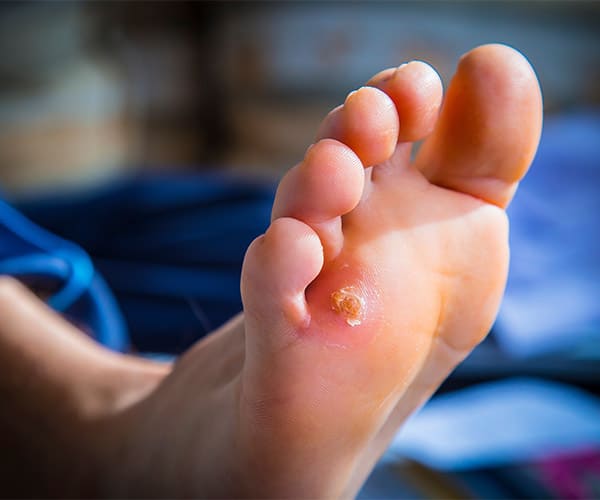Corns and Calluses
Corns and Calluses
Corns and calluses, also known as hyperkeratosis, develop as the body’s way of protecting itself from external pressure. These are common on people of all ages. When the body has an area that’s under pressure, it reacts by thickening the skin on that area. This can result in either corns or calluses, both of which are types of hyperkeratosis.
Corns are typically small, occur over bony prominences, and have a hard core. They are most common on the top of small toes or on the outside of the little toe. Calluses cover a larger area and are usually on the sole of the foot under the toes. This area takes the most weight when you walk.
Both conditions are typically painless, although sometimes a patient may experience pain or a burning sensation. Corns and thick calluses can sometimes feel like you’re walking on a pebble. The most obvious sign of a callus or corn is hardened, thick, yellow skin. Often, the skin will be less sensitive to touch as well.

- Causes
- Preventing
- Treatment
Causes of Corns and Calluses
There are a variety of causes of corns and calluses. Athletes and people who spend a lot of time on their feet are at greater risk of developing these as they are putting more pressure on their feet.
Having foot abnormalities can also cause the development of calluses and corns. Abnormalities in foot or toe anatomy, abnormalities in gait or the way you walk, and bunions can all create areas of pressure on the foot that lead to hyperkeratosis.
Lastly, poor fitting or tight footwear can create different areas of pressure and cause corns and calluses.
Preventing Corns and Calluses
If you spend a lot of time on your feet or play sports, preventing corns and calluses can be difficult. However, there are some things you can do to help or prevent them from progressing or getting infected.
- Wear proper fitting footwear at all times
- Offload pressure areas when possible
- Use lotion on your feet to keep the skin soft
- Do not cut corns or calluses yourself with any instrument
- Do not apply home remedies
Corn and Callus Treatment
There are a variety of callus and corn treatments. It’s important to note, however, that if your calluses and corns are not affecting you and not causing pain, they can usually remain untreated.
The best callus and corn treatment is to offload pressure areas. Wearing properly fitting shoes, toe props, and silicone devices can help to do this and make walking more comfortable for you. If your gait is the source of the problem, we can correct this with custom foot orthotics.
Your chiropodist can also perform corn removal, or debride or reduce the callus or corn safely. In extreme situations, they can also recommend surgery options to correct the cause of the corns or calluses, like bunion removal. Usually, however, corn and callus treatments are not this severe.
Collective Foot and Wellness Clinic in Hamilton can take care of all your orthotic and foot care needs, including your corn and callus treatment. Contact us today!
